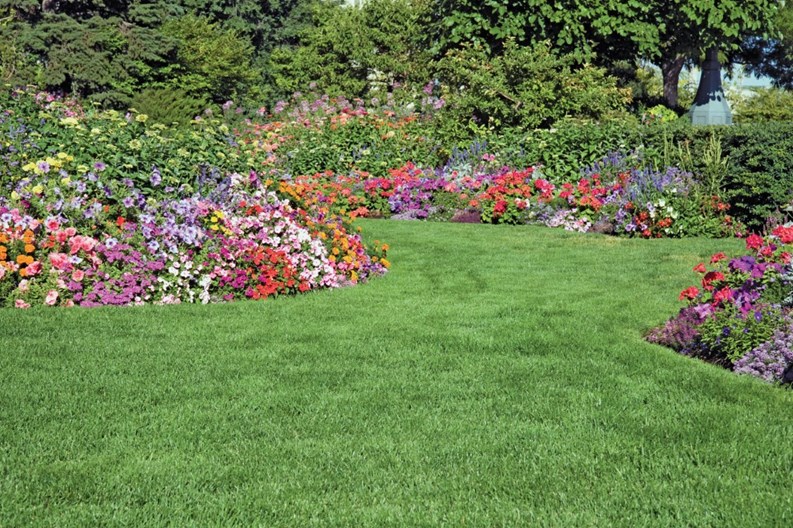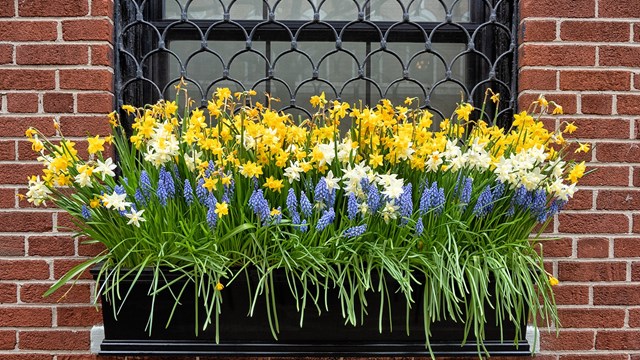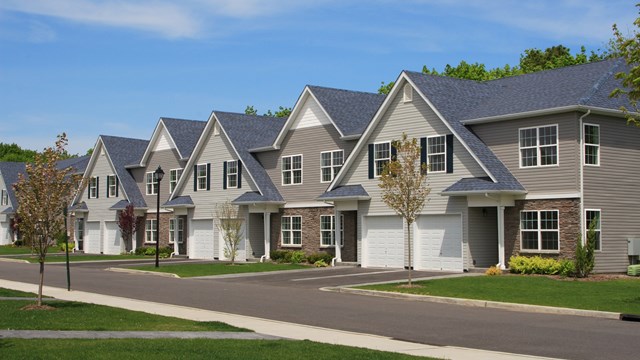Few capital improvements bolster property values as effectively as landscaping upgrades. Real estate professionals from across the industry agree that attractive, well-tended lawns, trees, shrubs, and plantings encourage sales and shorten turnaround times. And installing plantings better suited to your property’s ecosystem, including new hybrids specially developed to require less upkeep, can pay off handsomely in reduced monthly maintenance costs for years to come.
But these days, what HOA has a pile of money sitting around to spend on new petunias out front of the clubhouse, or for shrubbery beautification? The fact is, updating your landscaping and plantings doesn't have to entail a huge capital expenditure. By doing a little research beforehand and working closely with competent professionals who understand your goals, you can upgrade your greens without going into the red.
Hit the Books
If your board is considering a landscape renovation, a good first step is to take a look at accounts payable over the past few years to assess the cost benefits of an upgrade. The results may help persuade members and owners who are on the fence about investing in such a project. By going through your bills and determining where you're spending your landscaping budget, you can identify areas that are money-wasters and make them top priority. If your landscape professional is constantly being called out to or sending crews to your property to address a chronic problem, that's likely costing you more in service fees than it would to correct the underlying issue.
Once you've got an idea of what your problem areas might be, the next step, say the professionals, is to engage a landscape designer for a few hours of their time to walk your property with you. Do an assessment of existing plant materials to determine which have been properly located within the complex, and which ones might be moved to a more conducive spot, and which ones if any are just not appropriate and should be replaced. According to Mark Borst of Borst Landscape and Design in Allendale, "Usually, a property requires some degree of modification every five to 12 years. It may be a case of having the wrong plants in the wrong location, which can be resolved by transplanting existing trees, shrubs or annuals. Sometimes just a change in the amount of light through relocation or pruning can improve a plant’s performance."
The Lawn Haul
A sprawling expanse of lush, green lawn is one of the hallmarks of a thriving condo community for most people—so if your HOA's grass is looking mangy and unkempt, it can impact both community morale and property values. Landscaping professionals see a great deal of lawn abuse on their rounds from one property to the next. According to the experts, the most common mistakes associations make when taking care of their lawns include over watering, cutting grass too short and improperly applying fertilizers and pesticides.
“They don’t realize that this is a living organism/eco-system and needs to be treated as such,” says Chris Charnesky, owner of Vasile Green Landscaping in Wyckoff. “I often tell people that new grass is like an infant—it needs frequent watering and feeding and needs to be treated tenderly. They think that it’s just a carpet they can treat like a doormat, and then they wonder why it struggles.”
If your HOA's lawns are having a tough time, the professionals recommend consulting with your landscaper to work out a watering schedule that takes into account seasonal changes, the weather and climate, and the topography of your property. You can also figure out timing and scheduling for fertilizing your grass to optimize results and get your lawns back in the green.
It's also important to note that a well-functioning irrigation system is essential to maintaining not just a healthy lawn, but robust trees and shrubs as well, says landscape architect Christopher Faria, owner of Fieldstone Gardens in Little Compton, Rhode Island. “I had a big job this spring where the owners were wondering why the trees were dying," he says. Faria discovered that the trees on the property sat in standing water whenever it rained due to improper drainage. The good news, he says, is that most plants will recover once the irrigation problem is resolved. For walkways, patios, driveways that need resurfacing to improve irrigation, “A lot of people now are going with interlocking concrete blocks which can be stamped, colored or textured to look like brick or bluestone,” says Faria. “They are permeable and the way they lock together allows for drainage.”
A Matter of Placement
Condominiums built during the building boom of the 1980s were often forced to uproot overgrown trees on their grounds and replace those trees with grass. As a result of that strategy, these HOAs today often find themselves with outsized lawns, with a few trees scattered among the buildings. And to make matters worse, as the trees have matured, they’ve created a lot more shade, depriving the remaining plants of sufficient light. This creates an unbalanced, disproportionate landscaping scheme that doesn't do the association's curb appeal any favors.
“You’ll see Juniper growing eight feet tall and covering your front window or white pine trees planted right on the foundation,” explains Aaron Kurdyla, director of operations for the grounds maintenance division of High Tech Landscapes, Inc. in Branchburg. “Communities want to do phased-in plans of how they can uproot overgrown plants, improving their landscapes and bringing their communities up to date.”
If your association has found itself in this predicament, consulting with an experienced landscape architect or designer can help you work out a plan to revitalize your grounds with the right plantings in the right places. Which plants go where in a specific landscaping scheme has a lot to do with topography and drainage of course, but aesthetics play a role as well. Landscape architects will consider the different elements of design—which not only include landscaping materials like mulch and shrubs, but also the hardscape materials of paving, furniture, umbrellas, pergolas, arbors and fencing, according to Scott Levy, principal of Scott Alan Design, Inc., landscape architects/planners in Hamburg.
Landscaping is an art as much as it is a science, and creating a harmonious, visually pleasing arrangement of trees, flowerbeds, and other elements is part of the landscaper's role. "Regardless of the size or scope of a development," adds Borst, "its landscape plan should set the tone with aesthetic and functional components that complement the real estate. Lawns, gardens, flowers, trees, water and hardscape elements also need to be planned for immediate and long-term results.
"At older, well-established properties, a new landscaping program often focuses on updating and re-invigorating the landscape," says Borst. "A newer property may need a landscape renovation to reflect the image of the new owners or residents. That may mean a more formal look or a more casual 'country' look, altered or enhanced color, or the installation of hardscape areas. Creating patio areas and adding fountains, gazebos, picnic tables and benches provide residents with a place to relax and socialize with neighbors." A good landscape design has three main considerations: soil quality, climate and ultimate maintenance requirements."
Landscaping on a Budget
A condominium needn’t wait for flush times to begin livening up its landscape. There are ways to turn even a modest investment into impressive improvements.
First of all, it's important to realize that investing a little more at the beginning can actually result in savings later, says Borst. "Good initial planning for a new landscape installation or an upgrade at a multifamily residential property looks well beyond the short-term 'visual' results to ensure that the project—and its associated investment—continues to achieve its purpose for many years. In an industry where assignments often are awarded to the lowest bidder, it is important to understand that cutting corners can result in much greater costs down the road."
Also, you don't have to tackle everything all at once. Nearly any landscaping project can be broken down into phases. This is where your landscaper can really help by providing an assessment of what elements should be addressed ASAP, and which ones can maybe wait a season or two—or by recommending some low-cost items that give more bang for the buck. Replacing shrubbery that blocks windows and encroaches on walkways is a good place to start, as well as pruning trees and shrubs and clearing any dead plant matter and debris from your grounds. The larger, more costly jobs can be budgeted out over time. If 90 overgrown trees need to be replaced, you might commit to, say, planting 30 new ones over three years.
Kurdyla agrees, and recommends a phased-in plan, based on three, five or seven years.“This does take a commitment from the board and vendor,” he explains. “However, you can phase it in, and instead of spending a large sum of money in one year, you can phase it out over a number of years to get the most bang for your buck and also get the most broad-based appeal.”
“Another way to save money,” says Faria, is to “start with smaller plants—if you have the patience and you are in it for the long term. If you were to buy a four-inch caliper tree wholesale you might be looking at $300 or $400, whereas I can buy a one or two-inch caliper for maybe $100—and in two years with proper care that tree could easily be the same size as that four-inch caliper tree.”
"Plant choice and proper maintenance are critical," Borst agrees. "Low maintenance and drought-resistant plants reduce upkeep and irrigation costs, and organic techniques can minimize the use of expensive chemical treatments while protecting the environment."
For an economical, yet elegant decorative feature in a contemporary garden, Faria aslo recommends using boulders as sculpture, instead of expensive statues or lanterns.
One of the least costly enhancements condos can make to their outdoor space, recommends Faria, is to sink low-voltage lighting right below the mulch. Low voltage is not subject to the expensive safety precautions that 110V lighting requires and, aimed up at a tree or the side of a building, provides a dramatic effect at low cost.
The first step however, is actually taking the first step toward livening up your landscaping. “The biggest challenge I see in many communities is that they put money away on timeframes to reassess the roof and siding, but they don’t really put money away on a 15-20 year basis to reassess the landscaping,” says Kurdyla. “When they do, it shows they care more about their community, that they are an active community in terms of the membership taking a role in what they’re doing. It shows that they have an involved board and management team who are on top of things.”
"Your landscape welcomes visitors, and the same time creates a motivating quality as well as an area of respite for building tenants and their visitors," adds Borst. "And for the municipality in which the property is located, the landscaping can contribute to the overall beauty of a neighborhood, becoming a source of pride and even a local landmark." By actively partnering with your landscape professional and prioritizing projects, you can make big improvemements in your association or building's grounds regardless of whether your budget is $5,000 or $50,000. Landscape projects make a real difference in the face your HOA shows to the world, as well as to the sense of pride residents feel for their community.
Steven Cutler is a freelance writer from New York City. Additional research by David Chiu.







Leave a Comment